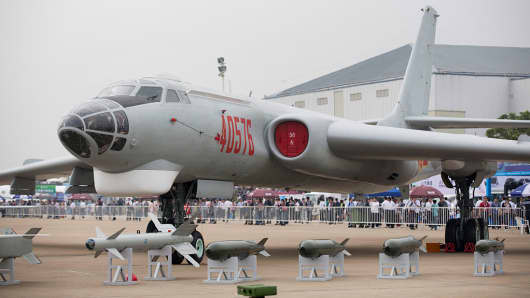By COURTNEY KUBE
HONOLULU — While much of the world is focused on the ballistic missile and nuclear threat from North Korea, the U.S. military in the Pacific region is also concentrating on a more lethal foe: China.
"PRC is the most pressing threat in the Pacific," one U.S. military official in the region said, using the acronym for the People's Republic of China.
"PRC is the most pressing threat in the Pacific," one U.S. military official in the region said, using the acronym for the People's Republic of China.
While North Korea is a near-term issue, "it's a fight we could win," the official said — but he worries about a fight with China.
Among the U.S. concerns: China's controversial island-building, theft of technology, currency manipulation, cyberattacks, and both military and non-military aggression.
The U.S. military officials in the region warn that China's ultimate goal is to become dominant by slowly making changes to the international order.
Among the U.S. concerns: China's controversial island-building, theft of technology, currency manipulation, cyberattacks, and both military and non-military aggression.
The U.S. military officials in the region warn that China's ultimate goal is to become dominant by slowly making changes to the international order.
China will use the laws it likes, ignore the ones it doesn't and eventually other nations will have to adapt, thereby re-setting the rules in China's favor.
"China is on a path to win without a fight," one official said.
The Chinese have changed the rules, for example, with their new man-made islands.
"China is on a path to win without a fight," one official said.
The Chinese have changed the rules, for example, with their new man-made islands.
In recent years China has transformed reefs, rocks and sandbars in the South China Sea into forward-based military installations, sparking a territorial dispute and diplomatic conflict.
The islands are hundreds of miles from the Chinese mainland in international waters.
The Chinese have declared an air defense identification zone (ADIZ) around the islands.
The Chinese have declared an air defense identification zone (ADIZ) around the islands.
If the Chinese enforce the zone and the international community begins to adhere to it, the islands will become accepted as Chinese territory.
"We ignore the problem too long and we can't tackle it anymore," said an official.
“China is on a path to win without a fight.”
One of the largest islands is Fiery Cross, complete with three expansive airfields, hangars for multiple fighter squadrons and several gun emplacements.
One of the largest islands is Fiery Cross, complete with three expansive airfields, hangars for multiple fighter squadrons and several gun emplacements.
While the Chinese military has not staged any aircraft or weapons there, the infrastructure is ready.
Man-made islands like Fiery Cross and Woody Island offer the Chinese a platform close enough to attack all U.S. operational bases in the region, as well as a number of close allies, the officials explained.
China "holds at risk a lot of operational bases," one of the officials said, which erodes the U.S. military advantage in the region.
Chinese dredging vessels are purportedly seen in the waters around Fiery Cross Reef in the disputed Spratly Islands in the South China Sea in this still image from video taken by a P-8A Poseidon surveillance aircraft provided by the United States Navy on May 21, 2015.
Man-made islands like Fiery Cross and Woody Island offer the Chinese a platform close enough to attack all U.S. operational bases in the region, as well as a number of close allies, the officials explained.
China "holds at risk a lot of operational bases," one of the officials said, which erodes the U.S. military advantage in the region.

Chinese dredging vessels are purportedly seen in the waters around Fiery Cross Reef in the disputed Spratly Islands in the South China Sea in this still image from video taken by a P-8A Poseidon surveillance aircraft provided by the United States Navy on May 21, 2015.
Another of China's strategies is to use its military forces without actually employing any hostile action, a strategy known as hybrid warfare.
For example, civilian fishing boats are being assigned to serve under military commanders.
The Chinese Navy uses them to harass or hit other nation's vessels who may not realize they are dealing with another nation's military.
The Chinese have also expanded their fleet of long-range aviation assets, like the H6K bomber, in an attempt to project more power and influence in the region, the officials said.
The Chinese have also expanded their fleet of long-range aviation assets, like the H6K bomber, in an attempt to project more power and influence in the region, the officials said.
They frequently fly these bombers over international waters within 1,000 miles of Guam, putting the U.S. territory in range of their air-launch cruise missiles.
"They are practicing attacks on Guam," one official said, calling the exercises "messaging" to the U.S.
Like the threat from North Korea, part of the concern from China lies in the potential for miscalculation or even misunderstanding.
Like the threat from North Korea, part of the concern from China lies in the potential for miscalculation or even misunderstanding.
Last year Japanese military aircraft flew roughly 900 sorties in response to Chinese aircraft in the region.
Scrambling jets every single day puts a strain on a close U.S. ally and raises tensions.
"It's a potential flashpoint," a U.S. military official in the region said, warning that these interactions "could bubble into conflict."
Two U.S. Air Force F-22 Raptor stealth jet fighters fly near Andersen Air Force Base in Guam in this handout photo dated August 4, 2010.

Two U.S. Air Force F-22 Raptor stealth jet fighters fly near Andersen Air Force Base in Guam in this handout photo dated August 4, 2010.
The U.S. military already has a number of forward deployed bases in the region, but in the case of conflict with China, the officials said, the U.S. would quickly establish about a dozen small, temporary Contingency Operating Bases (COBs) in remote locations.
These outposts would be located further from the conflict to keep some assets out of range of enemy attacks.
The military would rapidly prepare the sites to defend U.S. assets against hundreds of incoming rounds, using systems like THAAD and Patriot batteries.
The U.S. military recently practiced for this situation, rapidly deploying Air Force F-22s from a base in Alaska and setting them up at a location in the region.
The U.S. military recently practiced for this situation, rapidly deploying Air Force F-22s from a base in Alaska and setting them up at a location in the region.
The exercise addressed the logistical issues of moving quickly to a potentially harsh new environment.
Chairman of the Joint Chiefs of Staff Gen. Joe Dunford returned from a six-day trip to the Pacific late Monday night.
Chairman of the Joint Chiefs of Staff Gen. Joe Dunford returned from a six-day trip to the Pacific late Monday night.
He agreed that while North Korea is the immediate threat to the U.S., China is the enduring threat.
Joint Chiefs Chairman Gen. Joseph Dunford, speaks to reporters about the Niger operation during a briefing at the Pentagon on Oct. 23, 2017.

Joint Chiefs Chairman Gen. Joseph Dunford, speaks to reporters about the Niger operation during a briefing at the Pentagon on Oct. 23, 2017.
"China's path of capability development," said Dunford, "and their efforts I think to address our power projection capability, our ability to deploy when and where necessary to advance our interests, is very much the long-term challenge in the region."
The official said the U.S. military spends a lot of time making sure they don't forget about the long-term existential problem.
"We are ready" for North Korea, the official said. But the peer-level fight with China "is the real challenge."





